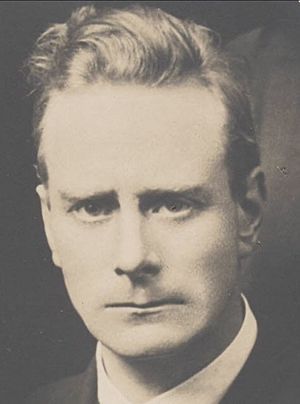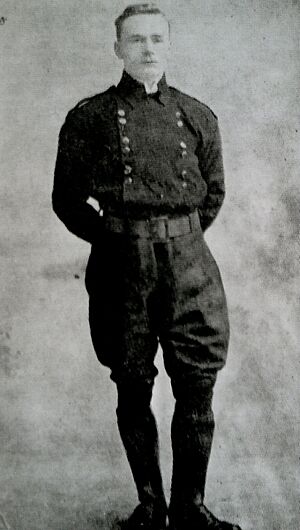Liam Mellows facts for kids
Quick facts for kids
Liam Mellows
|
|
|---|---|
 |
|
| Teachta Dála | |
| In office May 1921 – June 1922 |
|
| Constituency | Galway |
| In office December 1918 – May 1921 |
|
| Constituency | Both Galway East and Meath North |
| Personal details | |
| Born | 25 May 1892 Ashton-under-Lyne, England |
| Died | 8 December 1922 (aged 30) Dublin, Ireland |
| Political party | Sinn Féin |
| Military service | |
| Branch/service |
|
| Rank | Commandant general |
| Battles/wars | |
William Joseph Mellows (also known as Liam Ó Maoilíosa) was an important Irish leader. He was a Sinn Féin politician and a strong supporter of an independent Ireland. Liam was born in England but grew up in Ireland, living in Cork, Dublin, and Wexford.
He was involved with groups like the Irish Republican Brotherhood and Irish Volunteers. He took part in the Easter Rising in County Galway and the Irish War of Independence. Liam Mellows was elected as a TD (a member of the Irish parliament) to the First Dáil. However, he disagreed with the Anglo-Irish Treaty. During the Irish Civil War, he was captured. On 8 December 1922, he was one of four senior IRA men who were put to death by the Provisional Government.
Contents
Liam Mellows: His Early Life
Liam Mellows was born on 25 May 1892 in Ashton-under-Lyne, England. His father, William Joseph Mellows, was an English soldier in the British Army. His mother, Sarah Jordan, was Irish, from Inch, County Wexford.
In 1895, his family moved to Dublin when his father was transferred there. Liam stayed in Wexford with his grandfather because he was not well. He went to military schools in Cork and Dublin. But Liam decided not to become a soldier, which disappointed his father. Instead, he worked as a clerk in Dublin.
Getting Involved in Politics
Liam Mellows became an Irish nationalist when he was young. In 1911, he read a newspaper called Irish Freedom. He then met Thomas Clarke, who invited him to join Fianna Éireann. This was a group for young people who wanted an independent Ireland.
Liam also met other important figures like Con Colbert and Eamon Martin. On 7 April 1911, he joined the secret group called the Irish Republican Brotherhood. Mellows became an organiser and teacher for Fianna Éireann. He helped set up new groups in places like Ferns and Enniscorthy. He often cycled everywhere to do his work.
In 1913, Mellows met James Connolly, a socialist leader. Connolly was very impressed by Liam. Mellows was also a founding member of the Irish Volunteers. He worked full-time for this group, helping to organise it. He was arrested and jailed many times under the Defence of the Realm Act.
In August 1914, Liam Mellows helped bring weapons from Howth to Dublin. He was later sent to County Galway and made his base in Athenry. He continued to train volunteers there. He was arrested again in July 1915 and sent to Mountjoy Prison. After another arrest, he was sent to a prison in England.
The 1916 Easter Rising
Liam Mellows managed to escape from Reading Jail. He returned to Ireland to lead the "Western Division" of the IRA. This was during the Easter Rising in 1916.
He led about 700 Volunteers in attacks on police stations in Oranmore and Clarinbridge. They also took over the town of Athenry. However, his men did not have many weapons or supplies. They broke up after a week when British troops arrived. Liam Mellows and other leaders avoided capture thanks to the station master in Athenry.
Time in America
After the Easter Rising failed, Mellows escaped to the United States. There, he was arrested and held in a prison in New York. He was accused of helping Germany during the First World War. This was because German agents had bombed American ports.
After he was released in 1918, he worked with John Devoy. He helped organise Éamon de Valera's trip to America to raise money for Ireland. Mellows then returned to Ireland to become the "Director of Supplies" for the Irish Republican Army. His job was to buy weapons during the Irish War of Independence. In the 1918 Irish general election, he was elected as a TD for two areas: Galway East and Meath North.
Against the Anglo-Irish Treaty
Liam Mellows strongly believed that the Anglo-Irish Treaty was a betrayal of the idea of an independent Irish Republic. He said that Ireland should not become rich if it meant losing its honour. He believed the fight was for something more important than wealth or power.
In 1922, the Dáil (Irish parliament) voted to approve the Treaty. Mellows was one of the TDs who voted against it. He was seen as one of the strongest opponents of the Treaty. He also wrote a plan for social change. This plan was meant to gain support for the anti-Treaty side.
Civil War and His Death
Liam Mellows was a very strong voice as the Irish Civil War began. He was the quartermaster-general for the Anti-Treaty IRA. This group had taken over the Four Courts building in Dublin.
On 28 June 1922, Free State forces attacked the Four Courts. The IRA soldiers inside had to surrender after two days. Mellows had a chance to escape but chose not to. He was imprisoned in Mountjoy Prison in Dublin.
On 8 December 1922, Liam Mellows was put to death by a firing squad. This happened along with Rory O'Connor, Joe McKelvey, and Dick Barrett. Their deaths were in response to the shooting of a pro-Treaty TD named Seán Hales.
His Ideas and Beliefs
After his death, a document called "Liam Mellow's Jail Programme" was published. These were notes Mellows had sent out from prison. In this document, he suggested a ten-point plan for the Anti-Treaty IRA. Some of his ideas included:
- The state should own and control all major industries.
- The state should own the transport system and all banks.
- Large farms and estates should be taken and given to landless farmers.
- Workers should have a shorter working day.
- Workers should control their working conditions.
- Public services like trams and water should be run by local councils.
- All workers should be armed to protect their rights.
Mellows believed that Ireland needed to be owned by the Irish people. He felt it was important to free Ireland from foreign rule. He also believed Ireland should not fall under its own unfair rule later.
He had "broad internationalist sympathies." This means he cared about people in other countries too. He opposed the Treaty because he felt Ireland would join the British Empire's actions in places like India and Egypt. He was part of groups that fought against empires around the world.
Some people see Liam Mellows as a socialist republican. This means he believed in both an independent Ireland and socialist ideas. His writings from prison have been studied by many.
Remembering Liam Mellows
Liam Mellows is remembered in many ways across Ireland. There are statues of him in Eyre Square in Galway. An army barracks in Renmore is named Dún Úi Maoilíosa after him. Mellows Bridge in Dublin is also named in his honour.
Two GAA clubs, one in Galway and Castletown Liam Mellows GAA in Wexford, are named after him. He is also mentioned in the famous Irish song Take It Down from the Mast.
Liam Mellows is buried in Castletown cemetery in County Wexford. Every year, a ceremony is held at his grave. Many streets and places are named after him, including "Liam Mellows Avenue" in Arklow and "Liam Mellows Street" in Tuam. In 2016, a new gravestone was unveiled for him. A memorial statue was also unveiled in Finglas in December 2019.
Images for kids



